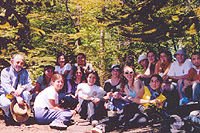
CLASSES (Indoors – Outdoors): UVM Schools and Departments are aware about the necessity of learning about diversity thus, all Regular and General courses at the UVM are open to international students.
For those international students who come in periods that do not coincide with the official semester schedule of our university, workshops and fieldtrips in areas that suit their academic and personal needs are developed for them.
We currently have a Japanese girl participating in a Spanish trimester program tailored to her needs. During orientation, Mau was asked to write a report about her Volunteer and Internship experiences in Japan. Mau wrote the following:
For those international students who come in periods that do not coincide with the official semester schedule of our university, workshops and fieldtrips in areas that suit their academic and personal needs are developed for them.
We currently have a Japanese girl participating in a Spanish trimester program tailored to her needs. During orientation, Mau was asked to write a report about her Volunteer and Internship experiences in Japan. Mau wrote the following:
"In Japan, I used to work at the big nature park called, The Park Fukushimagata Lagoon. In the park, I did tour guide for visitors from all over the countries. It was a great experience to learn so many things about the nature and animals.
It is in Niigata prefecture (northern part of Japan ) and located on the Sea of Japan side. It’s takes 2.5 hours by bullet train from capital city, Tokyo. The Fukushimagata Lagoon is a fresh water lake approximately 193ha in the area. Around this lagoon, visitors can see the birds over 220 kinds and 453 kinds of plants. The Fukusimagata Lagoon has been chosen as follows:Top 100 nature Spots in Japan, Top 100 Soundscapes of Japan, Top 100 Water-friendly towns of Japan and so on.
Also for migratory birds, The Fukusimagata Lagoon is the best place to take a rest for the migration. Since ancient times, people have been eased to looking at the Oohisikui (one of the species of geese) flying over The Fukusimagata Lagoon. Now, the Oohisikui is one of the natural monuments in Japan, and this lagoon supports the highest numbers of wintering population in Japan. The Oohisikui fly from Kamchatka, Russia, and staying from the end of September to the beginning of March. I love wild-nature and animals.
I heard and read from the books that Chile also have a great nature and people are supporting them. I would love to learn how people interact and preserve the nature in Chile. Also I have interested in learning the different variety of nature which is totally different the one in Japan. If possible, I hope I could join the hiking and nature tour with people who know about them very well so I could learn many things. After I go back to Japan, I hope I can tell about what I learned in Chile to my friends and come back with them". By Mayume Satake.
This report was read by Professor Dr. Jorge Redón, specialist in Environmental Sciences at our University, who immediately invited Mau to participate in a 5-day fieldtrip visiting some extraordinary parks located in a coastal desert zone in Northern Chile. Thus, our Japanese student will also have the possibility of exploring Fray Jorge Park. This park, declared by UNESCO as a World-wide Reserve of the Biosfera, displays an extraordinary and natural phenomenon: a forest with all the characteristics of a southern vegetation of Chile, but located in a coastal desert zone. [The existence of this forest depends on the condensation of the coastal fog, called “camanchaca”].
